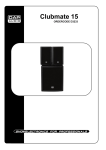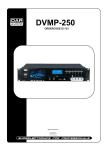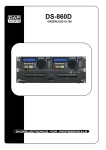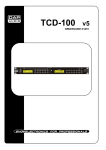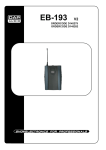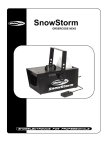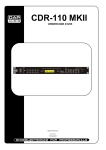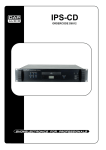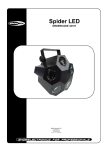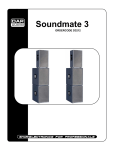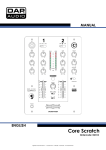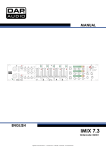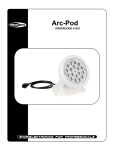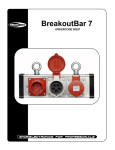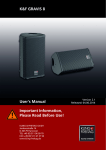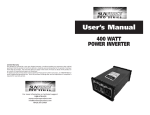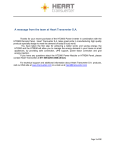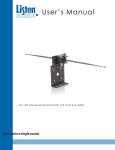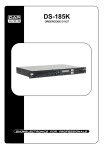Download PSS-6.5
Transcript
PSS-6.5 ORDERCODE D2602 Congratulations! You have bought a great, innovative product from DAP Audio. The DAP Audio PSS-6.5 brings excitement to any venue. Whether you want simple plug-&-play action or a sophisticated show, this product provides the effect you need. You can rely on DAP Audio, for more excellent audio products. We design and manufacture professional audio equipment for the entertainment industry. New products are being launched regularly. We work hard to keep you, our customer, satisfied. For more information: [email protected] You can get some of the best quality, best priced products on the market from DAP Audio. So next time, turn to DAP Audio for more great audio equipment. Always get the best -- with DAP Audio ! Thank you! Dap Audio Dap Audio PSS-6.5™ Product Guide Warning.........................................................................................................................................................................2 Unpacking Instructions...........................................................................................................................................2 Safety-instructions...................................................................................................................................................2 Operating Determinations.....................................................................................................................................3 Return Procedure....................................................................................................................................................4 Claims.......................................................................................................................................................................4 Description....................................................................................................................................................................5 Overview.................................................................................................................................................................5 Wireless Microphone............................................................................................................................................. 7 Remote Control......................................................................................................................................................8 Installation....................................................................................................................................................................10 Set Up and Operation.................................................................................................................................................10 Operating on AC power.......................................................................................................................................10 Operating on battery power................................................................................................................................10 Charging the PSS-6.5 built in battery....................................................................................................................10 Changing the battery of the PSS-6.5................................................................................................................. 10 Operating of the wireless microphones...................................................................................................................11 Changing the battery...........................................................................................................................................11 Before switching off the power..................................................................................................................................11 Inserting/changing the battery............................................................................................................................11 Tips for achieving maximum performance.........................................................................................................11 Connection Cables………..………………………………………………………………………..….…..……...................11 Maintenance...............................................................................................................................................................13 Replacing a fuse.........................................................................................................................................................13 Troubleshooting...........................................................................................................................................................13 Product Specifications................................................................................................................................................14 1 WARNING FOR YOUR OWN SAFETY, PLEASE READ THIS USER MANUAL CAREFULLY BEFORE YOUR INITIAL START-UP! Unpacking Instructions Immediately upon receiving this product, carefully unpack the carton and check the contents to ensure that all parts are present, and have been received in good condition. Notify the dealer immediately and retain packing material for inspection if any parts appear damaged from shipping or the carton itself shows signs of mishandling. Save the carton and all packing materials. In the event that a fixture must be returned to the factory, it is important that the fixture be returned in the original factory box and packing. Your shipment includes: • DAP PSS-6.5 • 1x Wireless Microphone • 1x Battery 9V • 1x Wireless Mic Antenna • 1x FM Antenna • 1x AM Antenna • Remote control (battery not included) • IEC cable (175cm) • User manual WARNING CAUTION! Keep this system away from rain and moisture! SAFETY INSTRUCTIONS Every person involved with the installation, operation and maintenance of this system has to: be qualified follow the instructions of this manual CAUTION! Be careful with your operations. With a dangerous voltage you can suffer a dangerous electric shock when touching the wires! Before you initial start-up, please make sure that there is no damage caused by transportation. Should there be any, consult your dealer and do not use the system. To maintain perfect condition and to ensure a safe operation, it is absolutely necessary for the user to follow the safety instructions and warning notes written in this manual. Please consider that damages caused by manual modifications to the system are not subject to warranty. This system contains no user-serviceable parts. Refer servicing to qualified technicians only. 2 IMPORTANT: The manufacturer will not accept liability for any resulting damages caused by the nonobservance of this manual or any unauthorized modification to the system. Never let the power-cord come into contact with other cables! Handle the power-cord and all connections with the mains with particular caution! Never remove warning or informative labels from the unit. Never use anything to cover the ground contact. Never leave any cables lying around. Do not insert objects into air vents or bassreflex ports. Do not connect this system to a dimmerpack. Do not switch the system on and off in short intervals, as this would reduce the system’s life. Do not open the device and do not modify the device. Do not drive the inputs with a signal level bigger, than required to drive the equipment to full output. Only use system indoor, avoid contact with water or other liquids. Avoid flames and do not put close to flammable liquids or gases. Always disconnect power from the mains, when system is not used. Only handle the power-cord by the plug. Never pull out the plug by tugging the power-cord. Always operate the unit with the AC ground wire connected to the electrical system ground. Make sure you don’t use the wrong kind of cables or defective cables. Make sure that the available voltage is not higher than stated on the rear panel. Make sure that the power-cord is never crimped or damaged. Check the system and the powercord from time to time. Please turn off the power switch, when changing the power cord or signal cable, or select the input mode switch. Extreme frequency boosts in connection with a high input signal level may lead to overdriving your equipment. Should this occur, it is necessary to reduce the input signal level by using the INPUT control. Avoid ground loops! Always be sure to connect the power amps and the mixing console to the same electrical circuit to ensure the same phase! If system is dropped or struck, disconnect mains power supply immediately. Have a qualified engineer inspect for safety before operating. If the system has been exposed to drastic temperature fluctuation (e.g. after transportation), do not switch it on immediately. The arising condensation water might damage your system. Leave the system switched off until it has reached room temperature. If your Dap Audio device fails to work properly, discontinue use immediately. Pack the unit securely (preferably in the original packing material), and return it to your Dap Audio dealer for service. Repairs, servicing and electric connection must be carried out by a qualified technician. For replacement use fuses of same type and rating only. WARRANTY: Till one year after date of purchase. OPERATING DETERMINATIONS This system is not designed for permanent operation. Consistent operation breaks will ensure that the system will serve you for a long time without defects. If this system is operated in any other way, than the one described in this manual, the product may suffer damages and the warranty becomes void. Any other operation may lead to dangers like short-circuit, burns, electric shock, etc. You endanger your own safety and the safety of others! Improper installation can cause serious damage to people and property ! 3 Connection with the mains Connect the device to the mains with the power-plug. Always pay attention, that the right color cable is connected to the right place. International L N EU (including UK) From April 2004 Brown Blue Green/Yellow North America Pin Black White Green Phase Neutral Protective Earth Make sure that the device is always connected properly to the earth! Return Procedure Returned merchandise must be sent prepaid and in the original packing, call tags will not be issued. Package must be clearly labeled with a Return Authorization Number (RMA number). Products returned without an RMA number will be refused. Highlite will not accept the returned goods or any responsibility. Call Highlite 0031-455667723 or mail [email protected] and request an RMA prior to shipping the fixture. Be prepared to provide the model number, serial number and a brief description of the cause for the return. Be sure to properly pack fixture, any shipping damage resulting from inadequate packaging is the customer’s responsibility. Highlite reserves the right to use its own discretion to repair or replace product(s). As a suggestion, proper UPS packing or double-boxing is always a safe method to use. Note: If you are given an RMA number, please include the following information on a piece of paper inside the box: 1) Your name 2) Your address 3) Your phone number 4) A brief description of the symptoms Claims The client has the obligation to check the delivered goods immediately upon delivery for any shortcomings and/or visible defects, or perform this check after our announcement that the goods are at their disposal. Damage incurred in shipping is the responsibility of the shipper; therefore the damage must be reported to the carrier upon receipt of merchandise. It is the customer's responsibility to notify and submit claims with the shipper in the event that a fixture is damaged due to shipping. Transportation damage has to be reported to us within one day after receipt of the delivery. Any return shipment has to be made post-paid at all times. Return shipments must be accompanied with a letter defining the reason for return shipment. Non-prepaid return shipments will be refused, unless otherwise agreed in writing. Complaints against us must be made known in writing or by fax within 10 working days after receipt of the invoice. After this period complaints will not be handled anymore. Complaints will only then be considered if the client has so far complied with all parts of the agreement, regardless of the agreement of which the obligation is resulting. 4 Description of the device Features Portable sound system with Radio/USB-/SD-/IPod- player and 1 wireless microphone • Built in self- charging battery pack • Output power maximum 60 Watt (PMPO) • Built in Radio/USB-/SD-/IPod- player • 1 Wireless microphone included Overview Fig. 1 1) SD/MMC-card Slot Use this slot to connect your SD/MMC-card for MP-3 playback. 2) USB Slot Use this slot to connect your USB stick for MP-3 playback. 3) IR receive window This sensor receives the information of the remote control. Don’t place any object or sticker in front of the sensor. 4) LCD Display 5) I-pod Slot Use this slot to connect your I-pod for playback. 6) Wireless Mic Antenna connector 7) High Use this control to adjust the High frequencies. 8) Low Use this control to adjust the Bass frequencies. 9) Mic 1 Jack Unbalanced Input ¼” unbalanced microphone input. 10) Mic 2 Jack Unbalanced Input ¼” unbalanced microphone input. 5 11) Echo level Use this control to adjust the level of the built in echo effect. 12) Power On/ Charge switch Position I is on, position II is charge, in between position is off. 13) AC Inlet with integrated fuse holder. This connector is meant for the connection of the supplied main cord. Connect one end of the power cord to the connector, the other end to the mains, then switch the Power (12) to positon I for operating the unit on AC power. Note: Please make sure that the supply voltage matches the operation voltage before connecting the unit to mains. Replace the fuse only with a fuse of same specification (F3A). 14) Aux level Use this control to adjust the level of the built in Radio/USB-/SD-/IPod- player. If you want to use the Aux- in (16) input, switch the Radio/USB-/SD-/IPod- player to line. Make sure to set the correct volume using the Vol – (30, 47) and Vol + (23, 55) buttons. 15) Mic volume Use this control to adjust the volume of the wireless Mic transmitter or the Mic inputs (9, 10). 16) Aux in Stereo Unbalanced RCA input Stereo Line level input. 17) Power Button Use the power button to turn the Radio/USB-/SD-/IPod- player on or off. 18) IPod-Tuner Button This button lets you select Radio, Line, I-pod, USB or SD as a source for playback. You can’t select the I-pod, USB or SD slot if there is no media (I-pod, USB stick or SD card) inserted. 19) Play In USB/SD/IPod mode you can use this button to start/pause playback. 20) USB/AMS Button Pressing and holding this button for more than 3 seconds starts ASM. If you decide to exit ASM before the search is finished, press the ASM button again. 21) Fast Backwards/B.Skip Button In USB/SD/IPod mode: Press this button to skip to the beginning of the current track, press again to skip to the previous track. Press and hold this button to play the track fast backwards. In Radio mode: While searching for a station manually. The frequency will decrease each time you press the button. Pressing and holding the button for more than 1 second starts a downward auto search. In auto search, the tuner will search the frequency band until a station of sufficient strength is found. 22) Fast Forward/F.Skip Button In USB/SD/IPod mode: Press this button to skip to the next track. Press and hold this button to play the track fast forwards. In Radio mode: While searching for a station manually. The frequency will increase each time you press the button. Pressing and holding the button for more than 1 second starts a forward auto search. In auto search, the tuner will search the frequency band until a station of sufficient strength is found. 23) Vol + Button This button allows you to increase the Volume level of the Radio/USB-/SD-/IPod- player. 24) Channel RF indicator Indicates the level of the incoming wireless signal. The intensity of the LED indicates the strength of the incoming wireless transmitter. 25) RPT Pressing this button allows you to repeat the current track or current folder. Exit the repeat mode by pressing the button again. 26) Stop Press this button to stop playback. 27) Charge LED Blinks if the built in battery is being charged. Lights continuously if the battery is 100% charged. 6 28) FM/ Loud Button Use this button to switch the Loudness function On or Off. In Tuner mode, holding the button for 3 seconds, lets you select the desired band. Pressing and holding the button for 3 seconds, lets you browse through the following modes and you select one of five bands as shown below. E.g.: Holding the button for 3 seconds while in FM2 will select FM3 etc. 29) Low Battery LED Indicates that the battery runs low and should be charged. 30) Vol - Button This button allows you to increase the Volume level of the Radio/USB-/SD-/IPod- player. 31) Power On LED Lights if the Radio/USB-/SD-/IPod- player is powered on. Wireless Microphone Fig. 2 32) Microphone On LED The red LED will light if the microphone is turned on. The LED will dim if the battery only has one hour or less of useful operating time. 33) Power On/Mute/Off switch This switch has three positions On, Mute and Off. Muting prevents the plop noise that sometimes occurs when turning the microphone off. The mute function also prevents background noise when the microphone is not used. 34) Frequency label Shows the (fixed) frequency the microphone operates on. 35) Battery compartment cover Access the battery compartment by removing the cover. 7 Remote control Fig. 3 36) Power Button Use the power button to turn the Radio/ USB-/SD-/IPod- player on or off. 37) Mute Button Use this button to mute the output. 38) 1 Play-pause Button In USB/SD/IPod mode, you can use this button to start/pause playback. In Radio mode, pressing this button will select preset 1. 39) 2 Stop Button In USB/SD/IPod mode, pressing this button will stop playback. In Radio mode, pressing this button will select preset 2. 40) 3 RPT Button In USB/SD/IPod mode, pressing this button allows you to repeat the current track or the current folder. Exit the repeat mode by pressing the button again. When in Radio mode, pressing this button will select preset 3. 41) 4 RDM Button In USB/SD/IPod mode, pressing this button will start the random mode. In random mode, the device plays the content of the current folder on your USB-stick, SD-card or IPod in random order. When in Radio mode, pressing this button will select preset 4. 42) 5 Down Button When in Radio mode, pressing this button will select preset 5. In USB/SD/IPod mode, the button will act as a folder down button. 43) 6 Up Button When in Radio mode, pressing this button will select preset 6. In USB/SD/IPod mode, the button will act as a folder up button. 44) Clock button Not functional in this version. 45) Fast Backwards/B.Skip Button In USB/SD/IPod mode: Press this button to skip to the beginning of the current track, press again to skip to the previous track. Press and hold this button to play the track fast backwards. In Radio mode: While searching for a station manually. The frequency will decrease each time you press the button. 46) Sel (Select) Button This button allows you select Radio, Aux, IPod, USB or SD as a source for payback. You can’t select the USB or SD slot if there is no media (USB stick or SD card) inserted. 47) Volume < Button This button allows you to decrease the volume level of the Radio/Line-input/USB-/SD-/IPod- player. 8 48) AS Button Pressing and holding this button for more than 3 seconds starts ASM. If ASM is activated, the PSS-6.5 will scan all the frequency bands in sequence for stations and automatically store them in memory. If you decide to exit ASM before the search is finished, press the ASM button again. 49) TU - Button Pressing the button starts an upwards auto search. In auto search, the tuner will search the frequency band until a station of sufficient strength is found. 50) Mode Button This button lets you select Tuner, Line, USB/SD and IPod as a source for payback. You can’t select the USB or SD slot if there is no media (USB stick or SD card) inserted. 51) Band Button Use this button to select the desired band. Pressing the button several times let’s you select one of five bands as shown below. 52) PS USB/SD In USB/SD/IPod mode, this button lets you select between SD-card or USB stick if both media are connected. 53) EQ Button Pressing the EQ button allows you select select one of the fixed equalizer settings. You can select 4 presets or switch the EQ off as shown in the figure below. FLAT: ROC: POP: CLASS: Gives you a flat frequency response. Gives you a frequency response optimized for rock music. Gives you a frequency response optimized for pop music. Gives you a frequency response optimized for classical music. 54) Fast Forward/F.Skip Button In USB/SD/IPod mode: Press this button to skip to the next track. Press and hold this button to play the track fast forward. In Radio mode: While searching for a station manually, the frequency will increase each time you press the button. 55) Volume > Button This button allows you to increase the volume level of the Radio/Line-input/USB-/SD-/IPod- player. 56) TU + Button Pressing the button starts a downwards auto search. In auto search, the tuner will search the frequency band until a station of sufficient strength is found. 9 Installation Remove all packing materials from the CD Player. Check that all foam and plastic padding is removed. Connect all cables. Always disconnect from electric mains power supply before cleaning or servicing. Damages caused by non-observance are not subject to warranty. Set Up and Operation Before plugging the unit in, always make sure that the power supply matches the product specification voltage. The power supply is printed on the back of the device. Do not attempt to operate an 115V specification product on 230V power, or vice versa. Connections 1. Turn off the Power switch. 2. Connect the PSS-6.5 to your other devices you plan on using. CAUTION: Be sure that the power is off, when connecting the cables. Operating on AC power • Make sure the Power (12) switch is in Off (middle) position and connect the power cable. • Switch the Power (12) switch to position I to run the PSS-6.5. The Power (31) LED will light green. Operating on battery power • Do not connect the power cable. • Switch the Power (12) switch to position I to run the PSS-10. • Switch the Power (12) switch to position 0 if you’re pausing, to save your battery. • If the battery is fully charged, the PSS-6.5 can run on battery power for approximately 1-2 hours, depending on the volume level. • If the battery runs low, the unit switches off. Charging the PSS-6.5 built in battery • Make sure the Power (12) switch is in Off (middle) position and connect the power cable. • Switch the Power (12) switch to position II to charge the internal battery of the PSS-6.5. • While the PSS-6.5 is charching, the red Charge (27) LED blinks. • Charge the battery for at least 8 hours. If the battery is fully charged, the red Charge (27) LED lights up continuously. Changing the battery of the PSS-10 • The PSS-6.5 has a built in battery. The battery can be charged aprox. 500 times if used properly. • Normally when fully charged, the PSS-6.5 can run for about 1-2 hours depending on the output volume. If the battery runs low very fast, despite being fully charged (at least 8 hours), the battery ran old and we advise you to replace the battery. • The battery should be replaced by a trained technician. 10 Operation of the wireless microphones Inserting/replacing the battery We recommend powering the microphone by a 9V PP3 alkaline battery. Fig. 4 Turn the battery compartment cover in the direction of the arrow and remove the cover. Insert the battery. Please observe correct polarity when inserting the battery. Close and lock the battery cover. Tips for achieving maximum performance. Make sure you can always see a receiver antenna from the transmitter position. Keep the distance from transmitter to receiver antenna as short as possible. Point the receiver antennas away from each other at 45 degrees angle from vertical position. Avoid placing the receiver antennas near metal surfaces and obstructions. Replace battery as soon as the low battery LED lights. Perform a walk-through before performance or presentation. If dead spots are found, adjust the location of the receiver. If dead spots remain, mark the dead spots and avoid them. Connection Cables Take care of your cables, always holding them by the connectors and avoiding knots and twists when coiling them: This gives the advantage of increasing their life and reliability. Periodically check your cables. A great number of problems (faulty contacts, ground hum, discharges, etc.) are caused entirely by using unsuitable or faulty cables. Headphones Unbalanced mono Balanced mono 11 Insert Compensation of interference with balanced connections 12 Maintenance The DAP Audio-CD-Player PSS-6.5 requires almost no maintenance. However, you should keep the unit clean. Disconnect the mains power supply, and then wipe the cover with a damp cloth. Do not immerse in liquid. Do not use alcohol or solvents. Keep connections clean. Disconnect electric power, and then wipe the audio connections with a damp cloth. Make sure connections are thoroughly dry before linking equipment or supplying electric power. Replacing a Fuse Power surges, short-circuit or inappropriate electrical power supply may cause a fuse to burn out. If the fuse burns out, the product will not function whatsoever. If this happens, follow the directions below to do so. 1. Unplug the unit from electric power source. 2. Insert a flat-head screwdriver into a slot in the fuse cover. Gently pry up the fuse cover. The fuse will come out. 3. Remove the broken fuse. If brown or unclear, it is burned out. 4. Insert the replacement fuse into the holder where the old fuse was. Reinsert the fuse cover. Be sure to use a fuse of the same type and specification. See the product specification label for details. Troubleshooting DAP Audio-CD-Player PSS-6.5 This troubleshooting guide is meant to help solve simple problems. If a problem occurs, carry out the steps below in sequence until a solution is found. Once the unit operates properly, do not carry out following steps. 1. If the device does not operate properly, unplug the device. 2. Check power from the wall, all cables, connections, etc. 3. If all of the above appears to be O.K., plug the unit in again. 4. If nothing happens after 30 seconds, unplug the device. 5. Return the device to your DAP Audio dealer. 13 Product Specification Power supply: Power consumption: Fuse: Speaker: Battery life: Frequency response: Rated power: Line input: Build in features: Frequency wireless mic.: Dimensions (LxWxH): Weight: AC 230 V - 50/60 Hz 80W F3A 2x 4,5” 1x 1” 1 - 2Hrs (depending on output level) 150Hz – 20kHz 30 Wrms 60W P.M.P.O. 2x Mic 1x Stereo Aux USB-/SD-/IPod- Player AM/FM tuner 1 Channel wireless microphone receiver 174,26 – 216MHz (Each unit has a different fixed frequency) 250 x 190 x 337 mm 8,8 kg Design and product specifications are subject to change without prior notice. Website: www.Dap-audio.info Email: [email protected] 14 2010 Dap Audio.

















